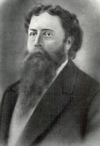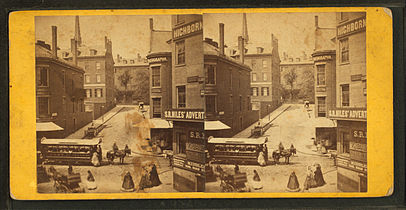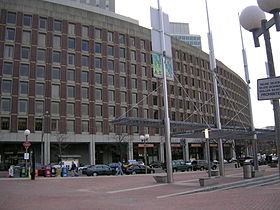
Pemberton Square (est. 1835) in the Government Center area of Boston, Massachusetts, was developed by P.T. Jackson in the 1830s as an architecturally uniform mixed-use enclave surrounding a small park. In the mid-19th century both private residences and businesses dwelt there. The construction in 1885 of the massive John Adams Courthouse changed the scale and character of the square, as did the Center Plaza building in the 1960s.
History
1835–1885
In the mid-1830s land on Cotton Hill (also called Pemberton Hill) between Tremont Street and Somerset Street was developed as Phillips Place, "laid out on the estates late of the heirs of Messrs. Phillips, Greene, and Lloyd." "After Greene's death in 1832, Patrick Tracy Jackson ... purchased the property. Jackson ... cut down the top of Pemberton Hill in order to create a desirable residential area halfway down the slope, at the point where the mansion had stood. This massive grading operation took only 5 months and was completed in October of 1835." The fill was used to reclaim the North Cove, which became the Bullfinch Triangle neighborhood of streets.

"Jackson sponsored a design competition for developing his property. ... Alexander Wadsworth, a local civil engineer and surveyor and one of 47 entrants, won the $500 prize." "In 1836, Jackson commissioned George Minot Dexter (1802–1872) to design the houses for Pemberton Square and all the accompanying ironwork (stair railings, fences for the small front yards, and the fence with lampposts for the central garden). ... The buildings would be consistent in style and ornamentation."
In 1838 the city named the site "Pemberton Square." Somewhat confusedly, the area later known as Scollay Square was first called "Pemberton Square" in February 1838; the city changed the name to "Scollay Square" in June 1838, to accommodate the newly developed area across the street on Pemberton Hill. The two squares sat very near one another, with Pemberton set back from Scollay, and accessed by a short connecting street.
"The dwellings built in it were fine, indeed elegant for their time, and for many years it was the residence of some of the most substantial citizens. ... Architects, lawyers, and other professional men were among the first to establish their offices in it; then other business worked in, and a number of city and state offices, notably the headquarters of the board of police commissioners." "In the middle of the square an enclosed green, with a few trees, which ... was a pleasant bit of nature for the eye of the city man to rest upon." During the city's Water Celebration in 1848, "the cavalcade up Park, down Beacon and Somerset Street, to Pemberton Square."

1885–present
"In 1885 the square was selected as the site for a new court house, the building of which had been agitated for years." "Houses on the west side ... were razed in 1885 to make way for the Suffolk County Courthouse. ... The garden was also eliminated at that time" By 1895, "some of the old swell-front houses remain, used as public and law offices."
Since the 1960s, Pemberton Square has become part of the complex of overscale buildings known as Government Center. "A few of the square's original dwellings on the east side survived until the autumn of 1969, when they, along with 2 more recent office buildings, were demolished and replaced by Center Plaza, a very long office building. The form of Center Plaza mirrores the entire crescent-shaped span of the original houses on the east side of the square, but the square itself no longer exists."
Tenants
Notable residents of Pemberton Square in the 19th century included:


- American Board of Commissioners for Foreign Missions
- American Colonization Society
- American Social Science Association
- Boston Conservatory of Elocution, Oratory, and Dramatic Art, later Emerson College
- Boston Police Department
- Boston School for Deaf-Mutes, later the Horace Mann School for the Deaf and Hard of Hearing
- Boston Society of Architects
- Boston University's "executive building, Jacob Sleeper Hall"
- Cummings and Sears, architects
- Cyrus Dallin, Sculptor
- Forest Hills Cemetery office
- Gridley James Fox Bryant and Louis P. Rogers, architects
- Edward Clarke Cabot, architect
- George Barrell Emerson
- Lee & Follen, landscape architects (Francis L. Lee and Charles Follen)
- Massachusetts Society for the Prevention of Cruelty to Children
- Mount Auburn Cemetery office
- John Plumbe, daguerreotypist
- Henry Vaughan (architect)
- Ware & Van Brunt, architects
Images
-
 Detail of 1838 map of Boston, showing Pemberton Square
Detail of 1838 map of Boston, showing Pemberton Square
-
 Detail of advertisement for Plumbe's daguerreotypes, in "the spacious hall over the Whig Reading Room, Pemberton Square," 1841
Detail of advertisement for Plumbe's daguerreotypes, in "the spacious hall over the Whig Reading Room, Pemberton Square," 1841
-
 Scollay Square, looking up to Pemberton Square, Boston, c. 1860s
Scollay Square, looking up to Pemberton Square, Boston, c. 1860s
-
 Advertisement for Lee & Follen, landscape architects, 1868
Advertisement for Lee & Follen, landscape architects, 1868
-
 Map of Pemberton Square, Court St. and vicinity. Boston, 1895.
Map of Pemberton Square, Court St. and vicinity. Boston, 1895.
-
 Corner near Scollay Square and Pemberton Square, Boston, 1897
Corner near Scollay Square and Pemberton Square, Boston, 1897
-
 Pemberton Sq.; Adams courthouse (at left), c. 1920
Pemberton Sq.; Adams courthouse (at left), c. 1920
-
 Center Plaza building at Pemberton Square, looking across Tremont St. from City Hall Plaza, 2005
Center Plaza building at Pemberton Square, looking across Tremont St. from City Hall Plaza, 2005
-
 Center Plaza building (at right), 2009
Center Plaza building (at right), 2009
-
 Adams courthouse (at right), 2009
Adams courthouse (at right), 2009
See also
- Gardiner Greene, former owner of land on Pemberton's Hill, later developed as Pemberton Square
- Massachusetts Appeals Court, housed in Suffolk County Courthouse
- Massachusetts Supreme Judicial Court, housed in Suffolk County Courthouse
- Social Law Library, housed in Suffolk County Courthouse
- Suffolk County Courthouse, built 1893
References
- Boston Almanac. 1838; p.63.
- Jonathan Phillips, Gardiner Greene, each with houses on Tremont in 1832. Cf. Boston Directory. 1832.
- James Lloyd, with house on Somerset in 1823. Cf. Boston Directory. 1823
- In the 17th century John Cotton and Henry Vane built houses on the land that later became Pemberton Square; later tenants included John Hull and Samuel Sewall. Cf. Edwin M. Bacon. Boston: a guide book, 2nd ed. Ginn and Company, 1922; p.20.
- ^ Phebe S. Goodman (2003), The Garden Squares of Boston, University Press of New England, ISBN 978-1-58465-298-4, OCLC 52631231, 1584652985
- ^ Bacon, Edwin M. (1886), Bacon's Dictionary of Boston, Boston: Houghton, Mifflin and Co., OL 7066965M
- Water celebration, Boston, October 25, 1848. Exercises at the fountain. American Broadsides and Ephemera, Series 1, no. 7232
- ^ King's How to see Boston, Boston: M. King, 1895
- Charles W. Millard. The New Boston: Government Center. The Hudson Review, Vol. 21, No. 4 (Winter, 1968-1969), pp. 687-692.
- Missionary Herald. 1872
- Memorial volume of the first fifty years of the American Board of Commissioners for Foreign Missions. 1862
- ^ Boston Directory. 1873
- Boston Directory. 1871, 1873
- Jane Holtz Kay (2006), Lost Boston, Amherst: University of Massachusetts Press, ISBN 1558495274, 1558495274
- "Pemberton Square Social Law Library Boston". SocialLaw.com. October 10, 2023. Retrieved October 10, 2023.
- ^ Boston almanac and business directory. 1894
- Boston Directory. 1848
- ^ Boston Directory. 1868
- "1-2-3 Center Plaza". Retrieved May 2, 2010.
Further reading
- "Cotton Hill" 1855, in City of Boston. 5th report of the record commissioners, rev. ed. 1880.
- One Center Plaza. (1963), Preliminary specifications: One Center Plaza, Government Center, Boston, Massachusetts, OL 23326859M
External links
- Flickr. Photo of old police headquarters, Pemberton Sq., 19th century
- MIT. Photos, 1950s:
- Scollay Square, looking down from Pemberton Square, 1956.
- Scollay Square Looking up Pemberton Square, From Court Street and Tremont Street, Suffolk Savings Bank
- Scollay Square Pemberton Square, Old Courthouse and Side of Scollay Square Theatre
- Scollay Square From Pemberton Square Looking Across to Cornhill Street
- Scollay Square Pemberton Square, Old and New Courthouses and Barristers Hall
- Flickr. Photo, 2006
- Flickr. Photo of Center Plaza, at former site of Pemberton Sq., 2007
- Flickr. Photo, 2009
42°21′31.19″N 71°03′41.44″W / 42.3586639°N 71.0615111°W / 42.3586639; -71.0615111
Categories: